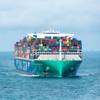Washington Gets Funds for Green Ferries
Washington State Ferries will begin the process of converting three Jumbo Mark II vessels from diesel to hybrid-electric power.
The government agency that operates automobile and passenger ferry service in the U.S. state of Washington as part of the Washington State Department of Transportation (WSDOT) announced Tuesday the state will receive $35 million from the federal Volkswagen settlement to retrofit the Tacoma, Wenatchee and Puyallup.
The ferry system is the largest consumer of diesel fuel in the state with over 18 million gallons of diesel burned each year, and the three Jumbo Mark II ferries account for 26 percent of total fuel consumption. This step brings the state ferry system closer to meeting the goals outlined in Gov. Jay Inslee’s Executive Order 18-01 (pdf 81 kb), which directs WSF to move toward a zero emissions fleet.
“Converting the biggest, dirtiest ferries in the fleet is a huge milestone in our efforts to decarbonize the state and fulfill our obligation to help defeat climate change,” said Inslee. “In addition to reducing emissions, moving to an all-electric ferry fleet will save taxpayers money on ferry operating costs, virtually eliminate engine noise and vibration that can hurt orca whales, and improve reliability of service.”
Reducing diesel exhaust and carbon pollution from marine vessels is one of the priorities identified for Washington’s share of the VW settlement by the Washington Department of Ecology, which oversees investing the settlement funds. Other sources will fund conversions of the remaining Jumbo Mark II vessels.
“Air pollution from diesel emissions is one of the most pressing public health threats facing Washington, and converting these ferries to hybrid propulsion will slash pollution in our state,” said Ecology Director Maia Bellon.
In September 2019, WSF selected Siemens to complete the propulsion system upgrade design for the three Jumbo Mark II Class vessels. The vessel conversion design will begin this month. Planning and design will continue through 2020 and construction will begin in 2021.
“At WSDOT we’re always looking for innovative solutions,” said Secretary of Transportation Roger Millar. “We are repurposing ferries in the middle of their service life, so they can continue serving Washingtonians for years to come in the most efficient, greenest way possible. This type of innovation and new technology will allow us to better serve our customers and manage growth.”
In addition to cost savings and reduced maintenance costs, converting the Jumbo Mark IIs will reduce carbon dioxide emissions by 48,565 metric tons per year – that’s like taking more than 10,000 cars off the road. Hybrid ferries will also cut the emissions of nitrogen oxide, a toxic form of air pollution, by 184.5 metric tons per year once all three ferries are operating with hybrid electric propulsion.
Constructed in the 1990s, the Jumbo Mark II class ferries are due for their mid-life propulsion system replacements, making for easy upgrades with minimal service disruptions. The ferries carry 202 cars and 1800 passengers each and primarily operate on the Seattle/Bainbridge and Edmonds/Kingston routes.
Hybrid electric propulsion and terminal electrification was one of the primary recommendations in the 2040 Long Range Plan that WSF released in January 2019. Hybrid electric conversion of the fleet’s largest vessels is the first step toward meeting system-wide emission reduction goals.













